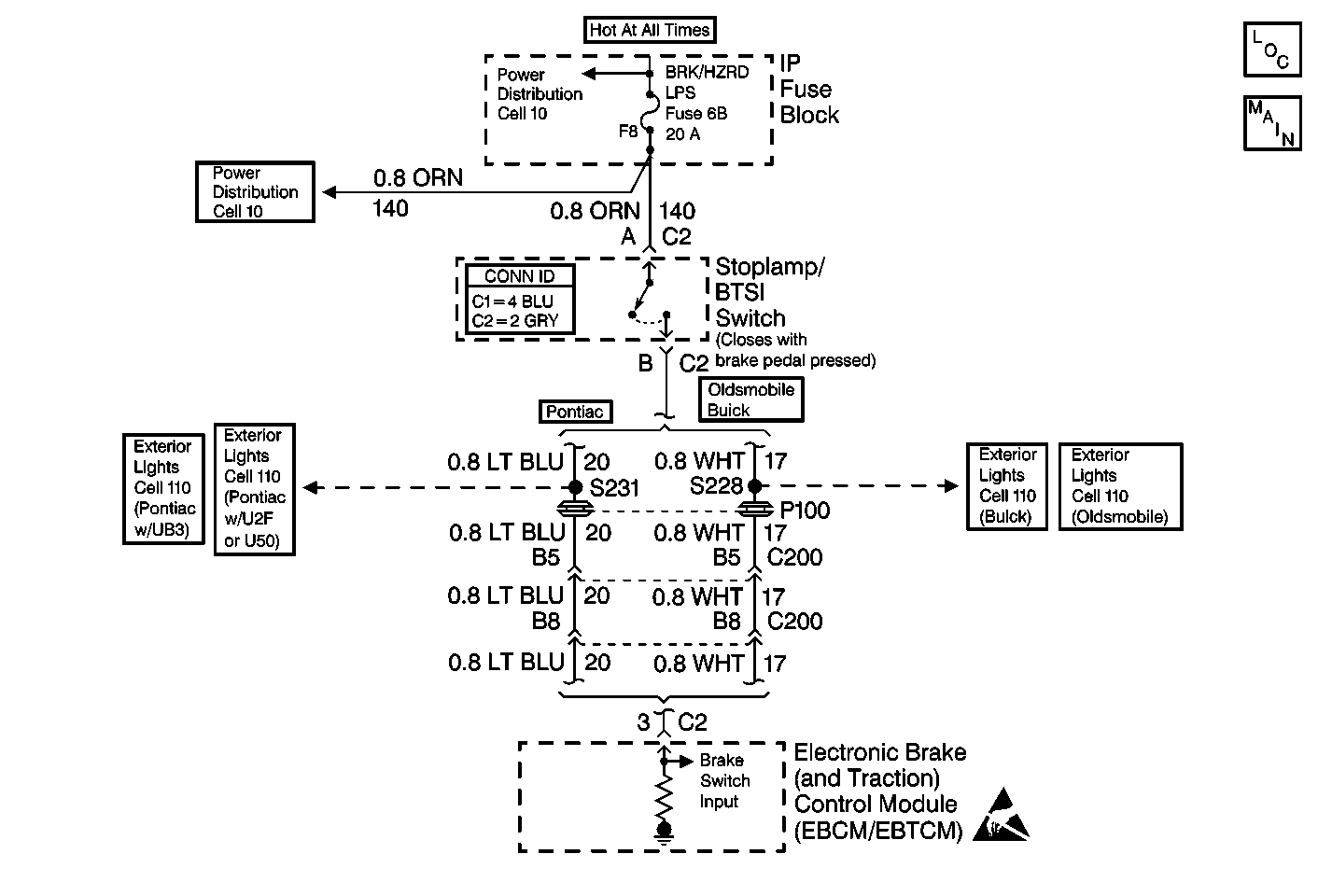
Circuit Description
This circuit is used to detect an open Stoplamp/BTSI switch in the non-ABS mode. The EBTCM looks for a deceleration rate that would indicate braking action and requires several repeats of this detection method in order to verify this assumption. In each case, the TCS will not be available since the EBTCM sees no Stoplamp/BTSI switch voltage.
Conditions for Setting the DTC
The Stoplamp/BTSI switch remains open for three deceleration cycles.
Action Taken When the DTC Sets
| • | A DTC C1291 is stored |
| • | The TCS is disabled |
| • | The TRACTION OFF indicator turns on |
| • | The ABS remains functional |
Conditions for Clearing the DTC
| • | The condition for the DTC is no longer present and the scan tool clear DTC function is used |
| • | 50 ignition cycles have passed with no DTCs detected |
Diagnostic Aids
| • | Thoroughly inspect the wiring and the connectors. Failure to carefully and fully inspect the wiring and the connectors can result in misdiagnosis. Misdiagnosis may cause replacement of parts without repairing the malfunction. |
| • | If any WSS DTCs are present, diagnose the WSS DTCs first. |
| • | The following conditions may cause most intermittent malfunctions: |
| - | Poor connections |
| - | Rubbed through wire insulation |
| - | A broken wire inside the insulation |
| • | The following conditions are other possible causes for this malfunction: |
| - | An open Stoplamp/BTSI switch |
| - | An open brake fuse |
| - | A misadjusted Stoplamp/BTSI switch |
| - | Erratic wheel speeds |
| - | A wiring problem, terminal corrosion, or a poor connection in the circuit |
| • | If an intermittent malfunction exists, refer to Intermittents and Poor Connections Diagnosis in Wiring Systems |
Test Description
The numbers below refer to the step numbers on the diagnostic table.
-
This step checks if the Stoplamp Switch and Power Distribution are OK.
-
This step checks for voltage at the EBTCM.
-
This step checks the Stoplamp Switch.
Step | Action | Value(s) | Yes | No |
|---|---|---|---|---|
1 | Was the Diagnostic System Check performed? | -- | Go to Diagnostic System Check | |
2 | Are any WSS DTCs present? | -- | Go to the appropriate DTC table | |
Press the brake pedal. Do the brake lights come on? | -- | |||
Is the voltage within the specified range? | Battery Voltage | |||
5 | Replace the EBTCM. Refer to Electronic Brake Control Module Replacement . Is the replacement complete? | -- | Go to Diagnostic System Check | -- |
6 | Repair the open or high resistance in CKT 17. Refer to Wiring Repairs in Wiring Systems. Is the circuit repair complete? | -- | Go to Diagnostic System Check | -- |
7 | Inspect the BRK/HZRD LPS fuse in the IP Fuse Block. Is the BRK/HZRD LPS fuse OK? | -- | ||
8 |
Is the voltage within the specified range? | Battery Voltage | ||
9 | Repair the open in CKT 140. Refer to Wiring Repairs in Wiring Systems. Is the circuit repair complete? | -- | Go to Diagnostic System Check | -- |
Connect a fused jumper wire between the stoplamp/BTSI switch harness connector terminals A and B. Do the brake lamps come on? | -- | |||
11 | Adjust or repair the stoplamp/BTSI switch as necessary. Refer to Stop Lamp Switch Adjustment or Stop Lamp Switch Replacement in Hydraulic Brakes. Is the repair complete? | -- | Go to Diagnostic System Check | -- |
12 |
Is the fuse OK? | -- | ||
13 | Repair the short to ground in CKT 140. Refer to Wiring Repairs . Is the circuit repair complete? | -- | Go to Diagnostic System Check | -- |
14 |
Is the fuse OK? | -- | Go to Diagnostic System Check | |
15 |
Is the fuse OK? | -- | ||
16 | Repair the short to ground in CKT 17. Refer to Wiring Repairs in Wiring Systems. Is the circuit repair complete? | -- | Go to Diagnostic System Check | -- |
